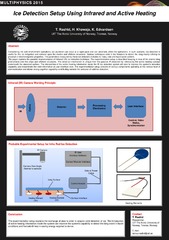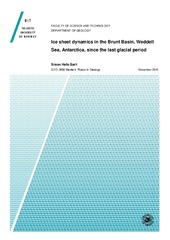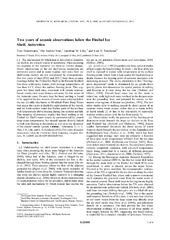Blar i tittel Fakultet for naturvitenskap og teknologi
Viser treff 1899-1918 av 4751
-
IA-SSLM: Irregularity-Aware Semi-Supervised Deep Learning Model for Analyzing Unusual Events in Crowds
(Journal article; Tidsskriftartikkel; Peer reviewed, 2021-05-17)Analyzing unusual events is significantly important for video surveillance to ensure people safety. These events are characterized by irregular patterns that do not conform to the expected behavior in the surveillance scenes. We present a novel irregularity-aware semi-supervised deep learning model (IA-SSLM) for detection of unusual events. While most existing works depend on the availability ... -
Ice Detection of Pure and Saline Ice Using Infrared Signature
(Journal article; Tidsskriftartikkel; Peer reviewed, 2016-11-30)The paper shows the possible implementation of an Infrared (IR) ice detection technique. In respect of safety in marine operations, saline ice detection can be significant for automated de-icing systems. Experimentation is performed to observe and detect saline and pure ice samples. The discussed detection mechanism is unique and differs from passive IR detection by introducing the self-heating ... -
Ice Detection Setup Using Infrared and Active Heating
(Conference object; Konferansebidrag, 2015)Considering the cold environment operations, ice accretion can occur at a rapid pace and can adversely affect the operations. In such scenario, ice detection is useful for the ice mitigation and removal upon the marine and offshore structures. Various techniques exist in the literature to detect the icing mainly utilizing its physical or electromagnetic properties. The parameters measured by these ... -
Ice extent in sub-arctic fjords and coastal areas from 2001 to 2019 analyzed from MODIS imagery
(Journal article; Tidsskriftartikkel; Peer reviewed, 2020-06-03)Results examining variations in the ice extent along the Norwegian coastline based on the analysis of Moderate Resolution Imaging Spectroradiometer (MODIS) images from 2001 to 2019, February through May, are presented. A total of 386 fjords and coastal areas were outlined and grouped into ten regions to assess seasonal and long-term trends in ice extent. In addition, three fjords were examined to ... -
Ice extent in sub-arctic fjords and coastal areas from 2001 to 2019 analyzed from MODIS imagery
(Journal article; Tidsskriftartikkel; Peer reviewed, 2020-06-03)Results examining variations in the ice extent along the Norwegian coastline based on the analysis of Moderate Resolution Imaging Spectroradiometer (MODIS) images from 2001 to 2019, February through May, are presented. A total of 386 fjords and coastal areas were outlined and grouped into ten regions to assess seasonal and long-term trends in ice extent. In addition, three fjords were examined to ... -
Ice in Norwegian subarctic fjords and coastal regions: An examination of ice formation, properties, and trends based on remote sensing and in situ data
(Doctoral thesis; Doktorgradsavhandling, 2022-09-16)Larger fjords along the Norwegian coast are ice free all year due to the influence of warm Atlantic water, however, sea ice can form in the inner parts of fjords and in smaller fjord branches. While a wide breadth of work exists examining mainland Norwegian fjords often focused on water mass dynamics and their link to biological processes, little research has been conducted on specifically sea ice ... -
Ice intelligence retrieval by remote sensing - Possibilities and challenges in an operational setting
(Peer reviewed; Chapter; Bokkapittel, 2017)Detecting ice drift velocity when operating offshore in ice-covered waters is crucial during marine operations, as ice actions affect station keeping and ice management. Furthermore, other ice data/intelligence such as ice concentration and thickness are important parameters to determine ice resistance, evaluate performance of icebreakers and predict ice actions on structures. Different sensors are ... -
Ice rafting, Ocean circulation and Glacial activity on the western Svalbard margin 0–74 000 years BP
(Doctoral thesis; Doktorgradsavhandling, 2015-03-27)The thesis builds on 11 sediment cores from c. 600 to 1900 m water depth from the continental slope west of Svalbard and one core from the Barents Sea shelf. Together, the cores cover the last 74,000 years. The primary goal was to gain a better insight in ocean circulation and glacial activity in a climatic context on glacial-interglacial and millennial time scales. The main parameters studied are ... -
Ice sheet dynamics in the Brunt Basin, Weddell Sea, Antarctica, since the last glacial period
(Master thesis; Mastergradsoppgave, 2016-11-15)High-resolution swath bathymetry, TOPAS sub-bottom profiles and four gravity cores from the Brunt Basin, southeastern Weddell Sea in Antarctica, were analysed with the purpose of reconstructing the ice sheet dynamics since the last glacial. Data collection was carried out by the British Antarctic Survey (BAS) and data analyses were carried out in a collaboration between the Department of Geosciences ... -
Ice Shelf - Ocean Interaction in the Eastern Weddell Sea, Antarctica
(Doctoral thesis; Doktorgradsavhandling, 2012-12-10)This thesis investigates the interaction of the Antarctic ice shelves along the coast of Dronning Maud Land with the ocean circulation in the Eastern Weddell Sea. A set of direct oceanic observations below the Fimbul Ice Shelf, which were acquired during three Antarctic field seasons in the austral summers 2009/10, 2010/11 and 2011/12, is a central element of the presented work. This new oceanographic ... -
Ice stream dynamics inferred from seismic geomorphology from the Bjørnøyrenna and Nordkappbanken area, SW Barents Sea
(Master thesis; Mastergradsoppgave, 2013-05-15)The aim of this master thesis is to investigate ice streams dynamics in Bjørnøyrenna and Nordkappbanken areas in south-west Barents Sea shelf Ice streams are responsible for the drainage of majority of ice from ice sheet and play a key role in the dynamic nature and stability of ice sheets, based mainly on six 3D seismic data sets,. Regional 2D lines are also used to establish the regional stratigraphy ... -
Ice, snow and polar bears: Decision making among professional guides in the Arctic
(Master thesis; Mastergradsoppgave, 2022-05-31)The purpose of this thesis is to study how Arctic Nature Guides make decisions in uncertain and ambiguous situations. In this context, guides face factors related to the guests’ expectancies to the guided tour, external risks, and aspects that influence their decisions. The terms crisis and crisis management are utilised to understand the contextual components throughout the decision-making process. ... -
Ice-albedo tipping points in a diffusive energy-balance model with land and ocean
(Mastergradsoppgave; Master thesis, 2021-01-20)The ice-albedo feedback is associated with the nonlinearity in the climate system, due to the sudden change in albedo between ice-free and ice-covered surfaces. This nonlinearity can potentially cause abrupt and dramatic shifts in the climate, referred to as tipping points. It is also believed that this mechanism has contributed significantly to the precipitous losses of Arctic sea ice, which have ... -
Ice-sheet Dynamics and Postglacial Sedimentary Processes of Coastal Søre Sunnmøre, Southwest Norway
(Master thesis; Mastergradsoppgave, 2020-05-15)Submarine glacial landforms have been identified and mapped in order to reconstruct ice sheet dynamics and to describe postglacial sedimentary processes of coastal Søre Sunnmøre in southwestern Norway which lies between 62 and 62.5⁰N. Landform identification has been accomplished through analysis of high-resolution multibeam echosounder (MBES) bathymetric data, backscatter data, LiDAR data, video ... -
Ice-sheet melt drove methane emissions in the Arctic during the last two interglacials
(Journal article; Tidsskriftartikkel; Peer reviewed, 2021-03-22)Circum-Arctic glacial ice is melting in an unprecedented mode, and release of currently trapped geological methane may act as a positive feedback on ice-sheet retreat during global warming. Evidence for methane release during the penultimate (Eemian, ca. 125 ka) interglacial, a period with less glacial sea ice and higher temperatures than today, is currently absent. Here, we argue that based on ... -
Ice-sheet-driven methane storage and release in the Arctic
(Journal article; Tidsskriftartikkel; Peer reviewed, 2016-01-07)It is established that late-twentieth and twenty-first century ocean warming has forced dissociation of gas hydrates with concomitant seabed methane release. However, recent dating of methane expulsion sites suggests that gas release has been ongoing over many millennia. Here we synthesize observations of B1,900 fluid escape features—pockmarks and active gas flares—across a previously glaciated ... -
Ice-stream dynamics of the SW Barents Sea revealed by high-resolution 3D seismic imaging of glacial deposits in the Hoop area
(Journal article; Tidsskriftartikkel; Peer reviewed, 2018-03-07)Recent developments in seismic acquisition systems and seismic data visualization have contributed to improve the imaging of seismic geomorphologies over a broad range of topics. This study focuses on a new high-resolution P-Cable 3D seismic cube located in the Hoop area in the SW Barents Sea. The scientific motivations of the study are (1) to document glacial landforms on a meter-scale, (2) to study ... -
Ice-water Classification in the Barents Sea from Sentinel-1 EW SLC Images
(Master thesis; Mastergradsoppgave, 2019-05-31)The focus of this thesis is to do ice-water classification on Sentinel-1 EW SLC imagery using an unsupervised Mixture of Gaussian segmentation algorithm. The classes are automatically labelled as sea ice or water based on the slope of the observed brightness decay from near- to far-range, which is different for sea ice and water. The aim of the thesis is twofold. In the first part, the ability of ... -
ICEBEAR-3D: A Low Elevation Imaging Radar Using a Non-Uniform Coplanar Receiver Array for E Region Observations
(Journal article; Tidsskriftartikkel; Peer reviewed, 2022-02-19)The Ionospheric Continuous-wave E region Bistatic Experimental Auroral Radar (ICEBEAR) has been reconfigured using a phase error minimization and stochastic antenna location perturbation technique. The resulting 45-baseline sparse non-uniform coplanar T-shaped array, ICEBEAR-3D, is used for aperture synthesis radar imaging of low elevation targets. The reconfigured receiver antenna array now has ... -
ICEBEAR: An All‐Digital Bistatic Coded Continuous Wave Radar for Studies of the E Region of the Ionosphere
(Journal article; Peer reviewed, 2019-04-15)The Ionospheric Continuous-wave E region Bistatic Experimental Auroral Radar (ICEBEAR) is a coherent scatter ionospheric radar. It operates at a frequency of 49.5 MHz, which is ideal for observing E region coherent echoes. The radar is located in Saskatchewan, Canada, and is operated by the University of Saskatchewan. The ICEBEAR system uses a continuous-wave (CW) signal and requires isolation between ...


 English
English norsk
norsk


















